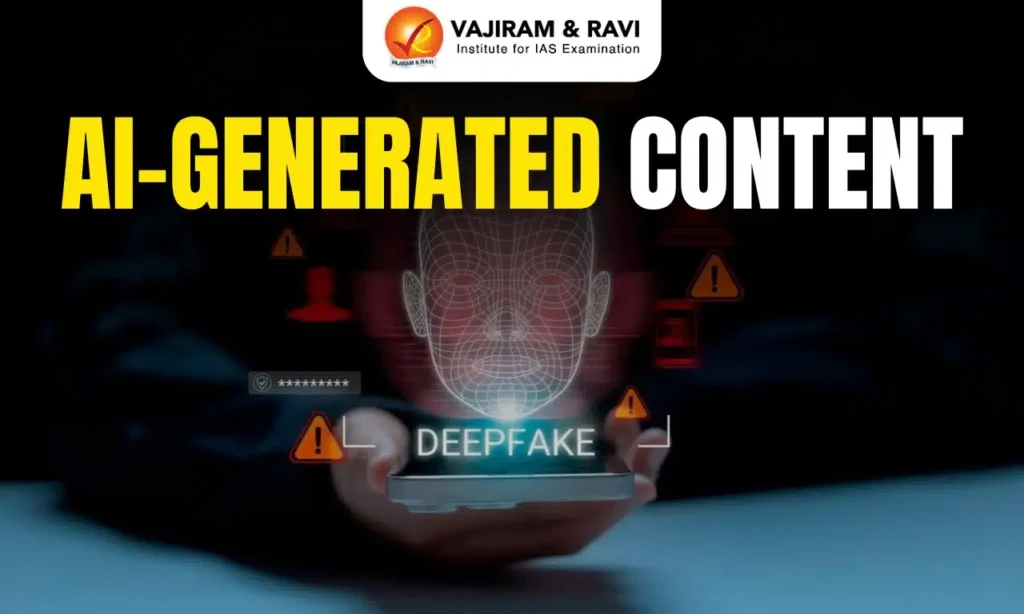The Ministry of Electronics and IT has proposed amendments to the IT Rules, 2021 that will mandate clear labeling of AI-generated content.
Latest news on AI-generated content
The Ministry of Electronics and Information Technology has proposed amendments to the IT Rules, 2021. AI-generated content must be labeled and declared on social media platforms to curb deepfakes and misinformation.
The rise of AI-generated content in India
In India, Artificial intelligence (AI) For content creation across social media, advertising, and entertainment.
However, this rise also raises concerns, including: synthetic contentespecially deep fakecreate hyper-realistic images, audio, and video using AI.
These operations blur the line between reality and fiction and are often used for political propaganda, financial fraud, and reputational damage.
Deepfakes gained national attention 2023,rear Digitally altered actor video The remarks went viral, sparking widespread outrage and a strong government response.
prime minister narendra modi He called deepfakes a new “crisis” and stressed the need for regulatory intervention.
News summary
of Amendment proposal to IT Rules, 2021try to achieve it Essential for creators and platforms to Declare and label AI-generated contenttext, audio, video, images, etc. uploaded to the Internet.
The purpose of this proposal is to Increase transparency and protect users from misinformationand protect democratic debate In the digital space.
Main provisions of the proposed regulations
Self-declaration obligations by creators:
Users who upload content to social media platforms such as YouTube, Instagram, and X (formerly Twitter) must: Declare whether content is synthetically generated.
Double labeling mechanism:
Platforms must ensure that AI-generated content is communicated. two visible markers:
Ann Embedded label or watermark Cover at least within the content itself 10% of video or audio length.
a Platform-level labels It appears wherever your content appears online.
Platform responsibilities:
If the User fails to make such declaration; Social media companies will be held responsible for Proactive detection and labeling Content generated by AI using technical means and automated tools.
Defining synthetic content:
The draft defines synthetically generated information as: “Information that is artificially or algorithmically created, generated, modified, or modified using computer resources in a manner that reasonably appears to be genuine or truthful.”
Consequences of non-compliance:
Platforms that fail to validate and label synthetic content May lose legal immunity under Section 79 of the IT Actcurrently protects intermediaries from liability for third-party content.
Metadata and identifier requirements:
AI-generated materials include Unique metadata identifier It is permanent and traceable, ensuring liability in case of misuse.
Scope of application:
This draft will not only help popular social platforms. AI content creation tool like OpenAI Sora and google geminia built-in watermarking and labeling system must be implemented.
Rationale behind the proposal
According to IT Minister Ashwini Vaishnauthe move addresses growing public concern about the misuse of synthetic content for manipulative purposes. He said:
“People are creating deepfakes that use images of celebrities to influence their private lives and cause social misunderstandings. In a democracy, users need to know what is real and what is synthetic.”
The Ministry’s briefing emphasizes that: Generative AI has the potential to create convincing falsehoodsleading to reputational damage, election interference, and financial fraud.
By requiring clear disclosure, the government aims to: Help users make informed decisions Regarding the authenticity of the content.
This marks a major shift in India’s digital governance approach. Previously, the government relied on the law’s general impersonation and fraud provisions. Information Technology Act, 2000However, with the advancement of AI tools, Certain regulatory safeguards.
International context and comparative framework
India’s move is consistent with global trends In AI regulation.
China I introduced something similar AI label method In 2025, AI-generated media such as chatbots and synthetic videos will require clear visual tags and hidden watermarks.
of European Union AI Law Requires transparency in AI interactions and requires users to be notified when using AI-generated content.
of US is developing federal guidelines While focusing on the reliability of content, Meta, Google, OpenAI We are committed to voluntary watermarking standards.
Therefore, India’s draft regulations position India as either: Early adopters of legally binding frameworks To combat misinformation in the age of generative AI.
Challenges of implementation and future prospects
Although the proposal enjoys wide support, experts warn that: Implementation complexity. Identifying AI-generated content in real time, especially across diverse formats and languages, requires: Advanced detection infrastructure.
moreover, Balancing regulation and innovation It remains. In rapidly growing India, excessive compliance burdens may inhibit small creators and startups. AI ecosystemthe appraised value is Over $12 billion By 2030.
To address this, the government is calling for: Public and industry feedback in the draft up to November 6, 2025indicating the intent to refine the framework prior to final notification.
If executed effectively, your labeling rules could look something like this: A global model for responsible AI governanceensuring that technological advances do not come at the expense of truth and public trust.
sauce: T.H. | IE
Frequently asked questions about AI-generated content
Q1. What do the new draft IT rules propose for AI-generated content?+
Q2. Who is responsible for labeling AI-generated content?+
Q3. What happens if the platform does not follow these rules?+
Q4. Why did the government propose these amendments?+
Q5. How do these rules compare globally?+
tag: AI generated content Main article upsc current affairs upsc main current affairs
Related articles
course




